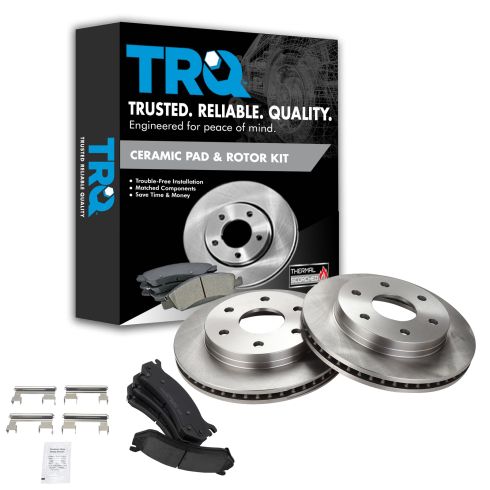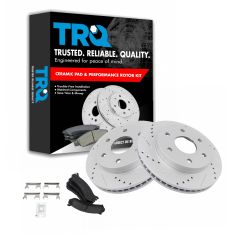1ABFS01425-Chevrolet GMC Cadillac Front Ceramic Brake Pad & Rotor Kit TRQ BKA11168

Replaces
2003 GMC Savana 2500 Van 7300LB GVW Front Ceramic Brake Pad & Rotor Kit TRQ BKA11168

Product Reviews
Loading reviews
4.76/ 5.0
25
25 reviews
Performed as advertised
April 15, 2016
Excellent delivery time, quiet braking, good fit and performance. All necessary parts included.
I recommend A1 auto 100%
January 10, 2018
My experience buying online with A1auto.com, just amazing as soon you type what exactly you looking for, there is a lot of products.
I buy a set of new rotors and brake pads for my chevy silverado they arrived before i was expecting.
And the parts was on perfect condition, for sure i will still buying more parts from A1auto.com
wrong parts
March 17, 2018
rotors were too small and pads didn't fit. Not for a 2007 gmc sierra classic
Great product great price
October 11, 2018
Much higher quality that your chain auto stores, have ordered for all 3 of my vehicles all have been great products
Excellent
June 23, 2019
Top of the line ??????????
1 A always right on
October 2, 2019
Always good prices. Always amazingly fast shipping.
I'm in for the long run.
Good parts
June 26, 2020
Fast good quality and cheap where I buy all parts unless they don't carry them
Parts fit perfect
July 20, 2020
So far I've purchased quite a few parts for multiple vehicles in the past months amd every part has fit perfect with no issue. I found this 1 auto just browsing and they had great reviews..Well ill definitely back those up amd will use this company for as long they are around. Shipping is pretty quick as well. Happy shopping!
Smooth
August 24, 2020
What you pay what you get, this item is better than what you paid for it.
Brake job
September 5, 2020
Good Price and easy installation. Quick delivery.
Break parts
September 10, 2020
All part fit great all working well!
Rotors and pads
December 23, 2020
Rotors and padsThe shipping is fast good service parts are good went together just fine no squeaking of the brakes so overall pretty happy with the parts
Perfect
April 27, 2021
Everything fit perfect as it should. Smooth stops, wet or dry pavement.
February 7, 2022
Fits perfect an easy to do yourself
April 19, 2022
Great part
May 6, 2022
Always good
Good deal
June 14, 2022
All parts fit perfectly and shipped quickly
September 14, 2022
Very GOOD Quality brake pads and rotors. I love 1auto. The name says it all. They are number 1 in auto parts and they get a A on quality and customer service.
Great experience
October 22, 2022
Top notch company
Ceramic brakes and rotors
November 18, 2022
The rotors and ceramic brake pads are excellent. As always they came when expected and top quality! Thank you 1A Auto. Not a promotional review, just a life long customer.
July 4, 2023
Best price best service
January 4, 2024
So far everything seems to be a class act excellent products
Brake repair
April 12, 2024
Good quality parts. Braking system restored to a smooth and quiet stop.
July 7, 2024
Seem to work well and were installed professionally. No complaints.
Great product
August 16, 2024
Brake pads and rotors were replaced last week. They are doing their job well. I just had to depress the anti-rattle clips a little more on the inner pads to get them to fit more smoothly.
Customer Q&A
What thickness are these rotors ? Bought some before but they weren't thick enough .
April 11, 2016
10
These are OE replacements. The thickness should not be different than what the factory specs are due to caliper and pad placement. Specs are not available
April 11, 2016
Brian F
10
Not know the exact thickness, but they worked perfectly on 2001 gmc sierra 4x4 extended cab.
April 11, 2016
Scott B
Are these the correct rotors and pads for a 2000 Chevrolet Silverado 1500 Z71?
February 20, 2017
10
Yes, these rotors and pads will fit your 2000 Chevy Silverado 1500 with the Z71 offroad suspension.
February 20, 2017
Alex P
Are these pads for single or dual piston calipers?
November 4, 2019
10
I used them on my 2004 GMC Sierra 1500 4x4 which had single piston calipers. They worked fine and are still working well. Hope this helps. Good luck.
November 4, 2019
DuWayne M
10
They work great nice smooth stopping
November 4, 2019
Vincent M
10
Dual pistons...installed on a 2000 suburbanLs 1500...
November 4, 2019
T V
10
The part should be able to fit for vehicles that have either option. As long as the vehicle fit is show for your vehicle it should be a direct fit. Please let us know if you have any further questions.
November 5, 2019
Emma F
Will these fit a 2001 gmc sierra with a 4.8 v8? I believe I have the 12 in rotors with the hub being about 7.74 in. Thanks in advance.
April 2, 2022
10
This will be able to fit for your vehicle as long as you have 6 lug wheels.
April 4, 2022
Emma 1
Will these fit 2006 silverado V6?
April 21, 2022
10
They should fit, more than likely Chevy Silverado from 99 - 07. However double check that the rotors you have on now have 6 holes for the wheel studs
April 22, 2022
Brett A
10
This kit will fit a 2006 Chevrolet Silverado 1500 with 4 Wheel Disc Brakes with 6 Lug Wheels.
April 22, 2022
T I
10
They should fit, more than likely Chevy Silverado from 99 - 07. However double check that the rotors you have on now have 6 holes for the wheel studs
April 22, 2022
Brett A
10
The part number# for that truck i this is.. TRQ BKA17001
April 25, 2022
Dan H
Im a little bit confused when I go to the auto parts store the two disc in a set of brake pads is going to run you twice as much did it cost here why is it lesser quality is it the same quality or is it just some type of part did you come by just to
June 3, 2022
10
These are manufactured by TRQ. TRQ is a high quality, high-end name brand that we offer and back with our 1A Auto Limited Lifetime Warranty.
June 3, 2022
Cristina P
10
Depending on whether or not you're doing front or rear brakes, you want to order a kit for front or rear, for example. I always order the kit that has replacement parts for both front wheels or rear wheels. So if, for example, you need front brake pads and rotors, but the calipers are in good shape, then order the kit for front brake pad and rotor pair . Hope this helps
June 17, 2022
Bryan P
will this work for the front passenger and driver as well as for rear passanger and rear driver? if not could you please point me towards the right parts? Thank you so much
June 3, 2022
10
In the description it states the kit Includes:
(1) Front Ceramic Brake Pad Set with Contact Point Grease & Hardware
(2) Front Replacement Brake Rotors
June 4, 2022
George B
10
Double check your vehicle information and order accordingly
June 17, 2022
Bryan P
10
Rear kit might be different, check your vehicle info.
June 17, 2022
Bryan P
How many discs?
June 17, 2022
10
This will come with four disc brakes.
June 17, 2022
Emma F
How many disks on the box?
June 17, 2022
10
There should be two per box. You have to do both rotors, so one pair for front brakes, one pair for rear brakes, hope this helps!
June 17, 2022
Bryan P
So this comes with 4 rotors?
December 13, 2022
10
This is a front set only. Two rotors, four brake pads
December 13, 2022
Charles P
10
Hello, this Kit Includes:
(1) Front Ceramic Brake Pad Set with Contact Point Grease & Hardware
(2) Front Brake Rotors
December 14, 2022
Ricale A
GMC is a registered trademark of General Motors Company. 1A Auto is not affiliated with or sponsored by GMC or General Motors Company.
See all trademarks.
















